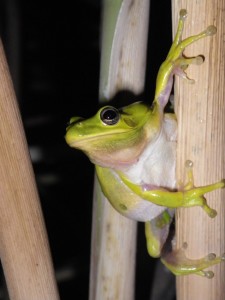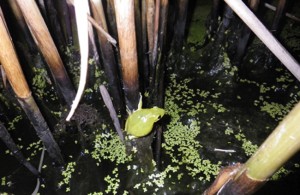Nature’s Chorus: Amphibian Calls
Conserve Wildlife Foundation Volunteers Survey For New Jersey Frog and Toads
by Larissa Smith, Wildlife Biologist/Volunteer Manager

Each spring, our Calling Amphibian Monitoring Project (CAMP) volunteers drive along a fifteen mile route after dusk, stopping at ten established stops along the route. They are hoping to hear the calls of some of New Jersey’s 17 species of frogs and toads. If they are lucky they’ll get to hear a chorus of several different species, sometimes so loud it’s almost deafening. Other times, they strain to hear a lone call from far away and many times they only hear the passing cars. It takes a dedicated volunteer to spend the time surveying and hearing only a few or no calls. But even the negative data is important, amphibians face many threats in New Jersey and establishing a long term database is key to learning about the population.
This season, twenty-one routes were surveyed and 16 of the 17 New Jersey frog and toad species were heard. The Eastern Spadefoot Frog was not heard this season. This year, the American Green Treefrog was recorded on one route in Salem County. This species of frog was first discovered in New Jersey in June 2011 in Salem County. The Northern Spring Peeper was heard on 19 out of the 21 routes, with Green Frogs heard on 15 routes and Northern Gray Treefrogs heard on 14 routes.

There are 63 CAMP routes through out New Jersey. Currently 34 routes are available for the 2016 CAMP season. If you are interested in volunteering for the CAMP project, please contact Larissa Smith via email.
Learn more:
Larissa Smith is the Wildlife Biologist/Volunteer Manager for Conserve Wildlife Foundation of New Jersey.

